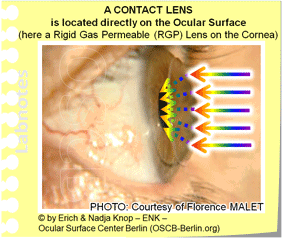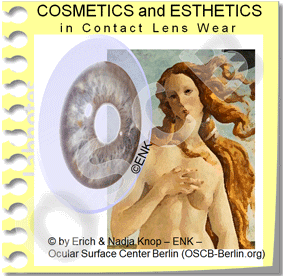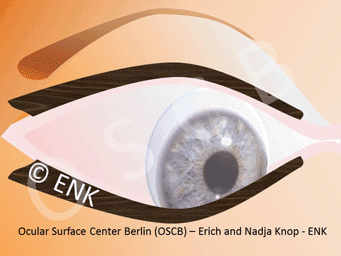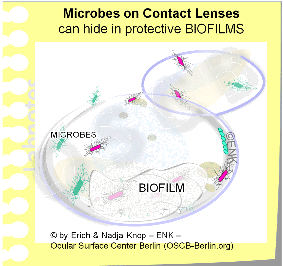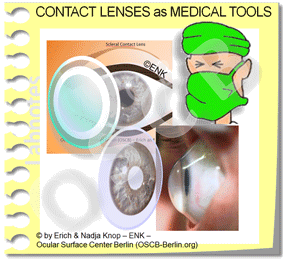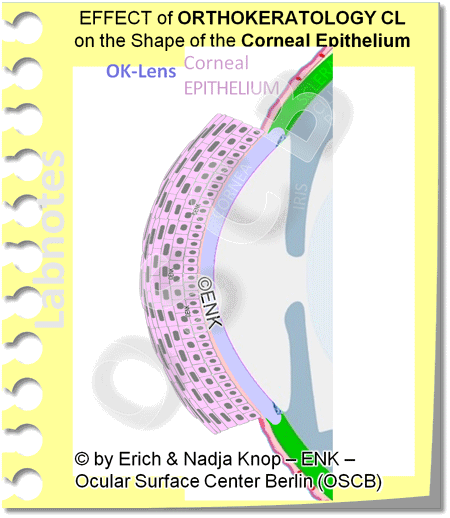Topics
Contact lenses are sitting in the middle of the ocular surface unit and have always been of interest for us
Since contact lenses are sitting in the middle of the ocular functional unit, they offer connections to many tissues at the ocular surface and they have remained of continuing interest to us. Members of the Ocular Surface Center Berlin (OSCB) have started their scientic work with contact lens studies.
Members of the Ocular Surface Center Berlin (OSCB) have served in the TFOS International Workshop on Contact Lens Discomfort (CLD). This initiative of the international scientific non-profit organization Tear Film and Ocular Surface Society (TFOS, www.tearfilm.org) has delivered the respective TFOS CLD REPORT in 2013 that found enormous world-wide interest.
Optical advantages of contact lenses
Contact Lenses can correct refractive errors directly on the cornea and have some optical advantages. They are great tool for the correction of refractive errors because they act directly where the main refraction occurs, i.e. on the cornea.
Contact lenses allow a larger field of vision without the limitations in peripheral areas that occur with spectacles.
Thereby contact lenses allow a more natural visual impression than glasses.
Higher refractive errors can be compensated without distorting effects and without the cosmetic disadvantage of thick ´bottle-bottom´ glasses
Contact lenses can also correct irregular refractive errors in astigmatism due to corneal irregularities, much better than glasses. This applies at least when the corneal irregularities are milder and when rigid lenses are used. Because contact lenses form a new regular smooth outer optical surface of the eye, they can ´iron-out´ smaller irregularities of the corneal surface. The underlying irregularities of the cornea are then located underneath the contact lens and are simply filled by tear fluid which makes them optically disappear.
A further medical advantage of Contact Lenses is the correction of refraction differences between both eyes (termed anisometropia). This may result in different size of the retinal images (termed ´aniseikonia´) with problems for the brain to fuse them into one single image - This is quite irritating and can lead, apart from insufficient visual acuity, to a headache. Since Contact Lenses are sitting on the cornea and are thus closer to the natural optical system of the eye, they produce less differences in image size.
The correction of refractive accommodation impairment with advancing age, known as ´long-sightedness´ (or ´presbyopia´), can often be nicely achieved by using contact lenses. There are different strategies for applying optical principles in order to provide an overall acceptable vision outcome for far and for near distances without the need for using reading glasses or even carrying two pairs of spectacles.
Apart from these optical advantages, contact lenses are often superior when it comes to outdoor activities and sports where the absence of physically potentially impairing spectacles is often desirable. In this setting contact lenses certainly provide better visual performance, decreased risk of wounding and more ´freedom´.
Cosmetic and Esthetic advantages of contact lenses
We do not know the opinion of Roman Goddess VENUS (the Greek Aphrodite - the goddess of love and beauty) about cosmetic contact lenses but she may likely have preferred to avoid changing her immaculate beauty by wearing glasses. On the other hand, as she is just seawater-foam-born when she arrives here in crete she may have kept in mind that contact lenses are not ideal to wear in water. The most likely conclusion is therefore, that Venus was in fact emmetropic, i.e. she did not have any refractive errors - which is good for her and for us, because we can come to a successful end with our contemplations.
A certain division can be made between cosmetic and esthetic contact lenses.
COSMETIC contact lenses typically change the outlook of a person in an intended way whereas
ESTHETIC contact lenses try to avoid a change of the (normal) appearance of a person who would need an optical correction and does not want to wear glasses.
Cosmetic Contact Lenses
Cosmetic contact lenses are typically worn for medical purposes, e.g. when the colored diaphragm of the IRIS, located slightly behind the cornea, has any kind of malformation.
Such malformations can derive from disease or trauma or can also be inherited. In the worst case no iris is present, which is termed ´aniridia´, or it can be split (Iris ´coloboma´) or the iris may simply have holes.
Such Iris malformations are not only of conceivable esthetic disadvantage but they also impair the visual function.
A missing iris leads to a great ´overflow of light intensity in the eye. More than one hole , i.e. ín addition to the natural central opening, in the eye can lead to more than one image on the retina - in theory there would be one image per hole. This leads typically to ´Double Vision´ (´Diplopia´). So there really is a medical need for ´COSMETIC´ Contact Lenses.
However, under the term ´Cosmetic´ falls also the intended change of the appearance of the eye in all possible styles ... that could possibly be related to alterations of the ´personal body image´, or is more frequently, intended to impress other folks typically in public appearances.
Hmmmmm..... It is certainly needless to say that particularly such ´FUN´ contact lenses can cause harm to the eye. They are worn by typically inexperienced individuals on unconventional wearing schedules and may even be exchanged among people in the peer-group (... oh, great ... let me try that on) which can cause all different sorts of side effects.
Esthetic Contact Lenses
Here a cartoon of a certainly very subjective view on the potential cosmetic advantage of spectales (this cartoon is often seen on internet pages ... but it was so far impossible for us to identify the original author)
Esthetic Contact Lenses are typically lenses that are worn because the individual needs an optical correction of his or her refractive error.
The refraction is then corrected by a Therapeutic Contact Lens if the individual does not like to wear spectacles because they are felt of esthetic disadvantage. Therefore Esthetic contact lenses are typically at the same time also therapeutic lenses.
Contact lenses can certainly be of esthetic advantage, apparently at least in view of many contact lens wearers as this seems to be the main reason for contact lens wear.
This applies even more to higher refractive orders that would need relatively thick glasses with ´bottle bottom´ appearance.
However particularly cosmetic and esthetic issues depend very much on subjective feelings ... and there are also opinions that highlight the potential improvement of an ´intelligent outlook´ by wearing glasses - well, that´s up to decide for every individual person.
Contact Lenses are in direct "contact" with the Ocular Surface
Contact lenses, as indicated by their name, are in direct contact with the Ocular Surface and Tear Film. They are
bathed and swimming within the tear film and
are located between the eye ball and the palpebral conjunctiva.
Contact lenses may therefore have the most direct potential impact
on the tear film and
on the ocular surface tissues
with the risk of potential negative side effects ... but also with great therapeutic potential as a medical tool e.g. as bandage lenses post-surgery or as the novel types of scleral contact lenses that have evolved as an exciting new multi-purpose medical tool for ocular surface restoration.
Contact lenses are swimming within the tear film
Contact lenses are typically swimming on the bulbar surface within the pre-ocular tear film.
This is necessary for the smoothness of wearing and for the exchange of tear fluid during a blink.
The exchange of tear fluid is necessary to allow access of fresh tears to the tissue underneath the contact lens, mainly for the cornea since this has no own blood vessels.
Contact lenses thus split the tear film into a pre-lens and a post lens tear film.
Contact lenses are more demanding for the tear film
Contact lenses are more demanding for the tear film and for the capacity of the ocular surface to produce such a volume of tears.
This is a reason why patients with dry eye disease, who typically have a lack of tears, have or develop (more) problems to wear a contact lens.
By their intimate relation with the tear film, contact lenses require a certain minimal amount of tear volume to be able to ´swim´. This minimal tear volume is higher than needed without wearing a contact lens. Contact lenses also increase the rate of evaporation of the aqueous phase of the tear film.
This explains, why patients with dry eye disease, who have an effective lack of tear volume on the eye, tend to become intolerant to contact lens wear even when they are used to contact lens wear and have worn a lens without problems before. On the other hand, individuals who appear to have a normal ocular surface but are in fact ´borderline´ normal, i.e. individuals where the available tear film is ´just good enough´, may develop dry eye symptoms when they are inserted a contact lens.
The latter case was actually the scenario in which Dr. DONALD KORB from Boston first identified Meibomian Gland Dysfunction (MGD) in patients who did not yet have problems without a contact lens.
… but then … why can contact lenses be used for a 'severe dry eye' ?
Patients with dry eye disease and a low tear volume typically have (more) problems to wear a contact lens - as explained above.
With this in mind, it comes as a surprise that contact lenses can be used in cases of dry severe eye disease as a very effective medical therapy instrument.
Such a lens, however, has a specific lens design (Scleral Contact Lens) that covers the almost whole anterior bulbar surface, that is normally exposed to the environment. Thereby, the available tear fluid is preserved in a tear-lake under the vault area of the scleral contact lens within a re-established kind of artificial ocular surface unit. These scleral contact lenses are explained in a separate chapter further down.
Contact Lenses Make Contact with the Tissue
Contact lenses still, inevitably, touch the ocular surface tissues – particularly the posterior lid border
Even though contact lenses are typically swimming in the tear film, it is still unavoidable that they touch the ocular surface and cause friction, in certain regions and under certain conditions.
The Posterior Lid Border is in prime contact with a Contact Lens
Contact Lens interactions with the Ocular Surface – A crtitical issue is the interaction between contact lens margin, posterior lid border and the corneal rim (limbus). Also, the contact lens margin typically exerts friction onto the bulbar conjunctiva.
A typical region of physical interaction between the contact lens and the wearer is the lens margin that gets in contact with the posterior eye lid border.
The posterior lid border is the region of the eyelid that is in most intimate contact with the eye ball. Most of the rest of the tarsal conjunctival surface of the eyelid appears to be slightly separated from the bulbar surface by the tear filled KESSING´s SPACE.
Lid Wiper epitheliopathy occurs in contact lens wear and is the most sensitive indicator for increased mechanical stress
The Lid Wiper is a specialised epithelial thickening of the posterior lid border (the Lid Wiper) is the surface. It is in most direct contact with the eye balls and it distributes the tears into the thin pre-ocular tear film during the up-stroke of the blink.
Therefore, the posterior lid border is the region that is exposed to the highest amount of friction between the eye lids and the eye ball. In any event where the friction is increased, e.g. in Dry Eye Disease or in Contact Lens wear, the Lid Wiper of the posterior lid border will conceivably suffer first and probably most.
There is evidence for this concept because destruction of the Lid Wiper epithelium, identified and termed as ´Lid Wiper Epitheliopathy´ by Donald KORB, Boston, was found to be the first an most sensitive indicator of increased mechanical stress at the ocular Surface.
The corneal center/apex may also be in touch with a contact lens
Depending on the fitting technique, the center of the lens may touch the apex of the cornea.
The contact lens moves with every move of the eye ball underneath and particularly with every one of the frequent eye blinks that occur about every 5-10 seconds to refresh the tear film. In the down-stroke of a blink the posterior lid border wipes over the contact lens margin.
The respective tissue irritation of the posterior lid border, which is the most sensitive region of the conjunctiva with highest nerve fiber density, is important This is usually the main issue during the adaption process of a wearer to a (new) contact lens.
Cornea-Scleral Lenses may potentially have negative influence on the Corneal Limbus
Movement of a soft corneoscleral contact lens – the most frequently used lens type - on the ocular surface during eye movements and blinking.
In addition, all this typically occurs in the region of the corneal rim (limbus) - when the most popular type corneoscleral soft contact lenses are used.
The corneal limbus is a particularly delicate and important area of the cornea (please see there in the chapter for ocular surface).
Even asymptomatic Contact Lens wear results in some morphological alterations of the surface tissue
At the same time, during a blink, the lens margin and lens are pressed stronger onto the bulbar surface when the upper lid comes down as compared to the inter-blink period.
This is due to the additional weight of the closing eye lid and due to the increased pressure of the lid margin that is exerted during a blink by contraction of the lid muscles.
Due to the increased mechanical friction in contact lens wear, even asymptomatic contact lens wearers have epithelial alterations in the form of squamous metaplasia of the bulbar conjunctiva in the contact lens excursion zone.
Contact lens HYGIENE is still an important issue
Contact lens hygiene has always been and is still an important issue in Contact Lens Wear. This is due to a number of reasons:
Contact lenses are inevitably in contact to microbes, mainly bacteria. This is e.g. due to touching the lens with the fingers of the user.
but even when the fingers are cleaned, they were still in contact with water of sometimes doubtful quality, particularly when it comes from roof-top containers or had long rested in (warm) water pipes.
Microbes are inevitable on the normal ocular surface and lid margin
they live there ´as pets´ and don´t do too much harm - in fact a certain number and type of microbes is even necessary to remain healthy through a constant stimulation of our immune system.
This is nowadays investigated under the term of the ´ocular surface microbiome´ - sounds great and is a great topic ! However, under certain conditions bacteria may increase in number and then even ´pet´ bacteria can pose a problem, such as conceivably in Meibomian Gland Dysfunction (MGD). Or they may be joined by more aggressive/ pathogenic ´comrades from the neighborhood´ - a switch to pathogenic microbes can easily lead to a clinically relevant infection.
The ocular surface is a wonderful ´moist chamber´ for the cultivation of microbes ... full of nutrients and with very pleasant temperature ... and over all ... it is moist ! - Even thought there is certainly a plethora of so-called ´anti-microbial peptides and proteins´ (abbreviated as AMP) at their protective work.
Contact lens wear must be perceived to cause inevitably and continuous minute micro-trauma to the ocular epithelial surface that may breach the tight barrier of the conjunctival and corneal epithelium. This may make invasion easier for the microbes - most of which can normally not penetrate the intact epithelium. These contemplations are not pure theory but they are in line with a distinctly higher rate of ocular infections in contact lens wearers compared to non-wearers.
Microbial deposits easily build up on contact lenses and their containers
A particularly cozy surrounding for microbes are typically not only the contact lenses but also their containers.
Many microbes can produce a fortress of so-called ´biofilms´ for their protection and can sit their unharmed, even in the presence of effective disinfectants.
The formation of bio-films is a general protective mechanism of bacteria and also occurs on the contact lenses, where it may lead to deposits that are difficult to remove.
=> This requires thorough contact lens cleaning and disinfection
Thorough cleaning and disinfection is important when wearing contact lenses
Not only soft contact lenses tend to accumulate microbial deposits. In principle, this applies to all types of contact lenses - albeit to varying degrees - and also to contact lens storage containers (!)
Just in case you may have acquired an eye infection in contact lens wear - please make sure to bring the contact lens and container to your eye doctor in order to allow a potentially easier identification of the responsible germ.
Thorough cleaning and disinfection is therefore important for all contact lenses (as shown in the drawing below):
Contact lenses should always be thoroughly cleaned and disinfected after wearing (1).
Cleaning
"Cleaning" means that the contact lenses must be mechanically cleaned of deposits with the (clean) fingers by carefully rubbing (2). The additional use of an enzymatic or other cleaning solution makes cleaning more effective.
Disinfection
"Disinfection" means that the contact lenses must also (afterwards) be chemically freed from possible bacteria, fungi and viruses in a suitable solution by killing the germs, usually overnight (3). For decades, so-called peroxide systems have proven to be particularly effective in this respect. These systems work with the weak acid hydrogen peroxide (H2O2) as a strong oxidizing agent and thus provide a very reliable disinfection. However, one must not forget to neutralize the acid again after and before inserting it into the eye (4).
The contact lens storage container should also be thoroughly cleaned and then air dried while the lens is worn on the eye (5) (6).
Some of these hygienic issues may be circumvented by the use of 'Disposable' Contact Lenses
Some of these hygienic issues can probably be circumvented by the use of 'Disposable' Contact Lenses - often one day lenses - that are thrown away after use and are replaced at the next occasion where they are deemed as necessary by a perfectly new and clear contact lens.
But even with daily disposable contact lenses a certain increased risk of wounding and infections will conceivably remain, because of the named inherent general risk factors of a higher risk for micro-trauma and for possibly keeping microbes under the lens in contact with the tissue for a longer time than without a lens. This must always we weighed against the expected advancements of contact lens wear.
Contact Lenses can be interesting MEDICAL TOOLS
Scleral Contact Lenses have an amazing potential as medical tools for many ocular surface conditions
Scleral Contact Lenses with high tech designs and novel material properties have an amazing potential as medical tools for many ocular surface conditions, including severe dry eye disease.
Scleral contact lenses are very large - they span the whole cornea and rest on the bulbar conjunctiva overlying the sclera (...which is "the white in the eye´). Since they cover and protect the cornea, they have an enormous potential to treat many ocular surface conditions that were previously difficult to address without the use of surgery. In certain cases, Sclerals can postpone or even replace surgery.
Scleral contact lenses can be custom-produced based on the automated measurements that the clinician can nowadays obtain with sophisticated instruments from the ocular surface of the patient. Such custom tailored and perfectly adapted, high-tech material Scleral Lenses are much easier to fit and much more comfortable to wear than historic lens types.
Orthokeratology ('ok') contact lenses can temporarily ´correct´ the corneal shape and refraction
Orthokeratology lenses can change the shape of the cornea overnight … see correctly during day time without a lens on the eye
Orthokeratology takes advantage of the effect that a rigid contact lens can slightly change the outer shape of the cornea - apparently without destroying or altering its integrity and health.
Thereby it is possible to ´adjust´ the shape of a cornea by overnight application of a rigid contact lens in order to correct the visual acuity. The temporary corneal shape ´correction´ typically remains for long enough time to have correct visual acuity during daytime without wearing this or another contact lens or glasses.
The change of corneal shape is only temporary and the ´original´ shape of the cornea will eventually re-occur when the OK-Contact Lens is removed. Therefore the OK-Lens must again be worn the next night in order to prolong and keep the effect.
Contact Lenses may have built-in SENSORS for monitoring different body functions
Many tempting ideas for the FUTURE of Contact Lenses (FROM: lifeboat.com blog 2016 03 fish-and-insects-guide-design-for-future-contact-lenses - Posted by Klaus Baldauf)
With the advent of technically refined material properties contact lenses appear to see new applications and indications. Applications means that contact lenses can be equipped e.g. with biosensors for the measurement of tear parameters, e.g. of glucose levels in diabetic patients. New indications means, e.g that the Large Scleral Contact Lenses are now seeing a revival as high tech curvature designs and novel material properties have given them an amazing potential as medical tools for many ocular surface conditions, including severe dry eye disease. They can postpone or even replace surgical treatments in a number of acute and chronic ocular surface diseases.


